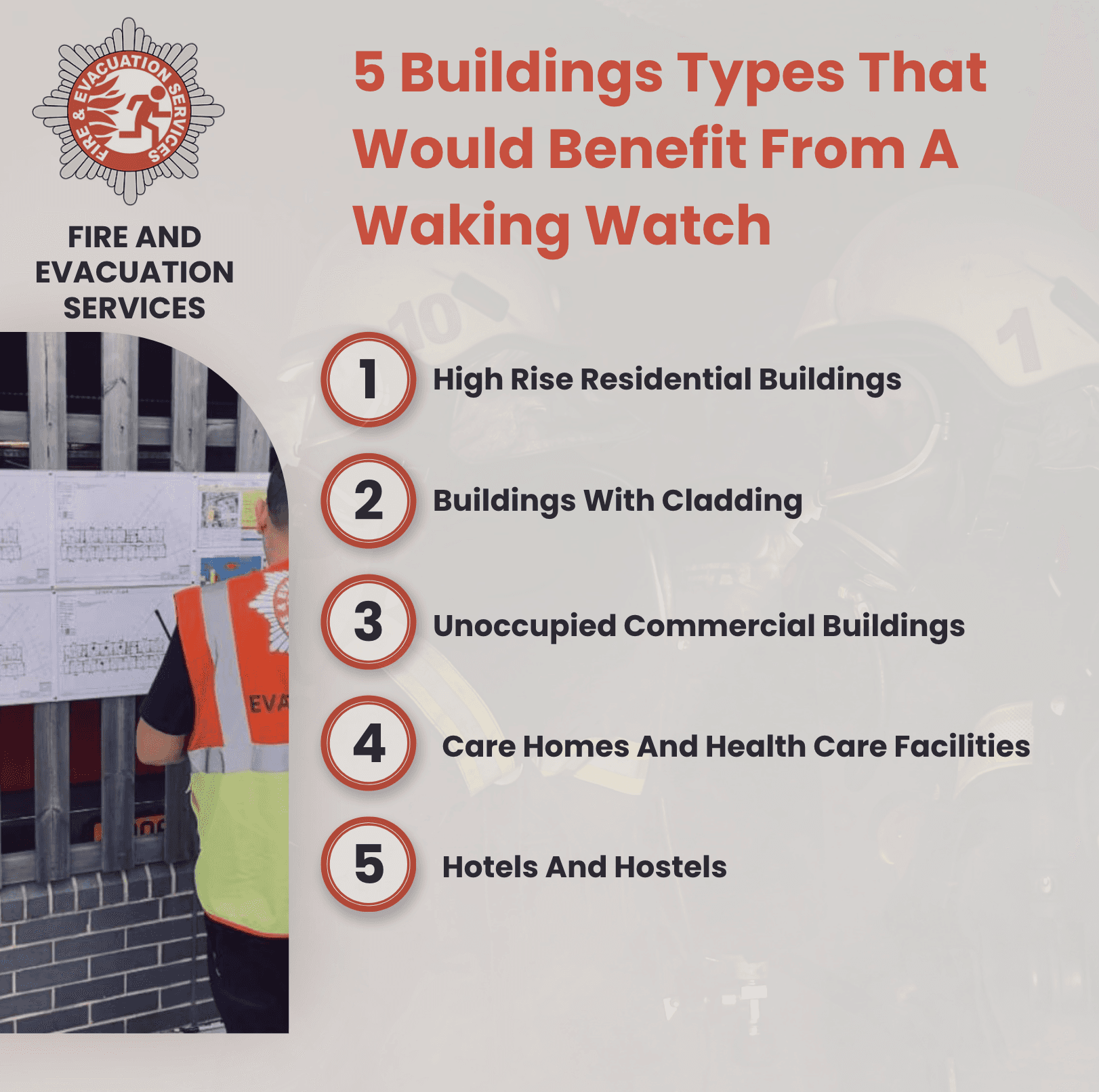Jan 31, 2024

What Is Waking Watch And Why Is It Important In Your Personal Emergency Evacuation Plan (PEEP)?
What is a waking watch?
Waking watch is a temporary fire safety system used to monitor high-fire-risk buildings. Buildings with combustible cladding or inadequate fire safety features are most at-risk and therefore require waking watch services. As of 31st March 2024, 1,501 buildings 11 meters and over in height have been identified as having life-critical fire safety defects (including cladding and non-cladding defects). All 1501 buildings will require some form of remediation and will require a waking watch service or to evict tenants until then.
A dedicated person(s) is appointed to warden high-risk buildings 24/7. Waking watch became part of building management safety as a response to fire safety problems in high-risk buildings. A Fire safety epidemic was highlighted in the UK by the horrific events at Grenfell Tower in 2017.
When would I need waking watch services?
There are various factors involved in determining whether a building requires waking watch officers:
When an evacuation strategy changed from 'stay put' (when other flats in the block are told to stay in the building because the fire is highly unlikely to spread) to simultaneous evacuation. The moment a change in status happens, they'll have to put in what's called a Waking Watch.
A fire safety officer will identify that there is something wrong in that building and will tell the person in charge of safety in the building that they will need a Waking Watch because of the change in strategy.
What does a waking watch do?
Waking watch services vary in level of experience and duties; some companies offer security staff and other companies use firefighters. Both types of waking watch businesses have benefits however, firefighter waking watch teams offer years of experience and are more responsive to fire emergencies.
Waking watch teams offer:
24/7 fire patrolling: Personnel patrol the building at all times to monitor for potential fire hazards or signs of fire.
Detect fires: Ensures that any fire or smoke is detected as early as possible.
Raise the alarm: In the event of a fire, personnel can act quickly to raise the alarm.
Evacuate: Ensure that people can begin evacuating as soon as possible. Helping people to exit the building safely, guiding them to assembly points, and ensuring that vulnerable residents are assisted appropriately.
Contact the fire service: In the event of a fire or emergency, they will contact the fire service immediately to report the incident.
Act as a point of contact: They are a key point of contact for residents in case of fire-related concerns.
Support personal emergency evacuation plans: The team will be aware of individuals who need special assistance and will help implement their PEEP.
Continuous risk monitoring: Monitoring the building’s fire alarms, firefighting equipment, and evacuation routes, reporting any concerns or issues to building management or fire safety authorities.
What is a PEEP (Personal Emergency Evacuation Plan)
A personal emergency evacuation plan is an individual, tailor-made plan to help people who have specific needs in the event of an emergency, specifically when fire evacuation is required. PEEPs are actionable evacuation plans made up of 6 sections (see ‘What should your PEEP include’ below) to ensure that individuals with mobility, sensory, cognitive, or other needs can safely leave a building during an emergency.
A responsible person such as landlords, employers, or building managers will ensure that a PEEP is generated for any new tenants/staff in need. The responsible person will decide who needs to be assessed for a PEEP based on their needs. Physical or mental well-being will be considered to determine if a person would struggle to reach safety unaided.
People who need a personal emergency evacuation plan:
People with limited mobility (e.g. people with difficulty walking and/or climbing up stairs, and wheelchair users)
People with sensory impairments (e.g. people who are hard of hearing, deaf or have visual impairments)
People with cognitive impairments (e.g. those with learning disabilities or dementia)
People who require medical equipment (e.g. individuals who rely on oxygen tanks or other medical devices)
How does waking watch impact PEEP?
Whilst waking watch is not directly linked to PEEP, it can impact evacuation planning and safety measures for tenants and staff within a building. Waking watch companies will assist in implementing personal emergency evacuation plans by alerting residents of the building so the PEEP can be actioned. Security staff and/or firefighters who are running the fire protection program will be aware of who in the building requires support and will have an understanding of their PEEP.
In some circumstances, when a new waking watch service is implemented, a review or update of an existing PEEP could be triggered to ensure new fire procedures are taken into account.
A waking watch system will help with the overall safety of the building and its residents who need PEEPs in place. Offering assistance, overnight monitoring, and early fire detection, will have a positive impact on vulnerable residents' mental health, ensuring peace of mind and comfort.
Waking Watch And PEEPs Are Crucial For Safety
In conclusion, whilst a waking watch system is first and foremost a short-term fire safety measure, it plays a critical role in ensuring the safety of individuals who rely on personal emergency evacuation plans. By providing round-the-clock monitoring, a waking watch will ensure that individuals with sensory, physical, or cognitive needs are supported and protected in the event of an emergency.
There are many options for waking watch companies, we are firefighter-led. At Fire and Evacuation Services, we take immense pride in evacuation management and elevating the standards of what an organisation can expect from a waking watch. We have high levels of competence and experience drawn from our extensive fire & Rescue backgrounds. We use our expertise gained from our roles as Fire Wardens.
Although waking watch isn’t a long-term solution, it can prompt reviews of PEEPS and much-needed support for other residents whilst permanent safety features are put in place. Combining waking watch with a well-structured PEEP is the key to providing peace of mind and securing the safety of all building occupants.
